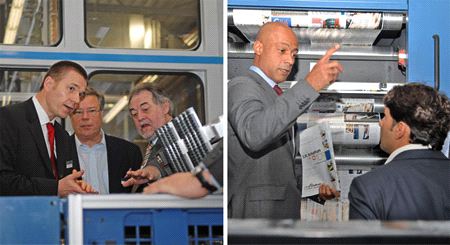Offset Printing
KBA C16: the ideal 16pp web press for frequent job changes

Thursday 02. December 2010 - Open House at L.N. Schaffrath in Geldern, Germany
Last Friday 150 or so representatives from prominent web press printing plants in eleven countries joined a gaggle of trade journalists in hall 7B at German printer L.N. Schaffrath in Geldern for an open house promoting the technological and economic benefits of a new 16pp web press, the KBA C16. The highly automated 65,000iph press demonstrated its ability to pump out multiple short-run magazine titles with a minimum of makeready.
Following the opening speech by L.N. Schaffrath joint managing director Dirk Devers his fellow md Dirk Alten provided a brief profile of the 250-year-old company. The 300-odd full-time staff at L.N. Schaffrath DruckMedien produce around 180 magazine titles plus diverse catalogues and brochures, generating annual sales of some 44m ($58m). A second business unit, L.N. Schaffrath Neue Medien, has ten employees and annual sales of 1m ($1.32m). The one 48pp and two 16pp web presses consume approximately 25,500t (28,000 US tons) of paper per year, entailing 45 million adhesive binding and 50 million stitching and addressing sequences. During the same period the two 16pp press lines print approximately 6,000 jobs averaging 36,000 copies. Ten makereadies and 15 changeovers are the daily norm.
Print runs cost-effective from as little as 7,000 copies
Dirk Alten cited the dominance of small circulation titles, and the flexibility these demand, as the reason why L.N. Schaffrath opted for a 16pp press. The choice of the new KBA C16 was influenced by KBA’s openness to practical innovations and, more specifically, the press’s high-speed job changes supported by intelligent automation and operating systems. For example, in recent months magazines with circulations as low as 7,000 copies have occasionally been transferred from sheetfed to the new web press.
Response to present-day challenges
KBA deputy president Claus Bolza-Schünemann described the C16 as KBA’s response to the challenges currently confronting printers in the commercial and magazine sectors. “Diminishing print runs, demands for enhanced product quality and diversity, price constraints and rapid turnaround all underscore a need for greater production flexibility and faster job changes. In an increasingly fragmented market, faster, wider presses for up to 96 pages A4 are not always the solution – in fact they are often the problem. This was KBA’s experience many years ago in the publication rotogravure sector.”
Rudolf Sturme, head of technology at L.N. Schaffrath’s printing plant, presented a frank performance report illustrating events from the presshall extension to the installation and commissioning of the KBA C16, its launch into three-shift operation, and press acceptance. The overall verdict was so positive that the company has since placed an order for a KBA Rapida 106 five-colour B1 (41in) sheetfed press with coater.
Complete job change in eight minutes
KBA’s head of web press technology Patrick Schneppe listed the C16’s many operational benefits. These include automated plate changing in less than one minute and a complete job change – including a change of stock and conversion to an adhesive-bound 16-page product – in around eight minutes. KBA EasyTronic pushbutton speed reduction from the standard minimum of 12,000iph during automatic run-up to just 6,000iph cuts waste to well below 1,000 copies, while automated roller locks reduce maintenance input and roller abrasion. Dedicated AC drives for each printing couple (two per unit) eliminate the need for drives, clutches and a mechanical circumferential register, making press run much smoother and more energy-efficient. Minigaps and blanket plates help optimise print quality, as do the autoconvertible superstructure and folder with just one quarterfold for speeds up to 65,000iph. A press demonstration with a complete job change, hosted by Patrick Schneppe and product manager Hubert Kistner, compellingly confirmed Schneppe’s figures for makeready and waste. Following conversion from a normal to an adhesive-bound and ready-trimmed 16-page product, start-up waste was around 700 copies.
